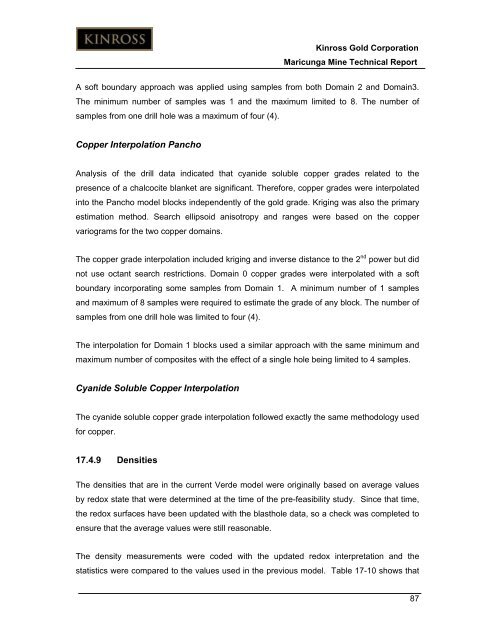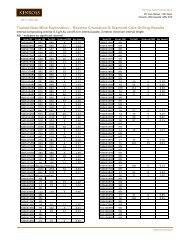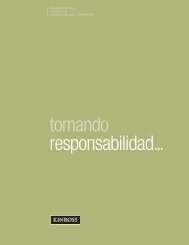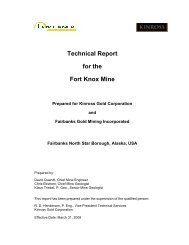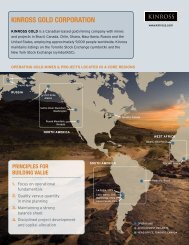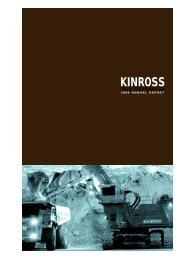Technical Report for the Maricunga Gold Mine - Kinross Gold
Technical Report for the Maricunga Gold Mine - Kinross Gold
Technical Report for the Maricunga Gold Mine - Kinross Gold
- No tags were found...
Create successful ePaper yourself
Turn your PDF publications into a flip-book with our unique Google optimized e-Paper software.
<strong>Kinross</strong> <strong>Gold</strong> Corporation<strong>Maricunga</strong> <strong>Mine</strong> <strong>Technical</strong> <strong>Report</strong>A soft boundary approach was applied using samples from both Domain 2 and Domain3.The minimum number of samples was 1 and <strong>the</strong> maximum limited to 8. The number ofsamples from one drill hole was a maximum of four (4).Copper Interpolation PanchoAnalysis of <strong>the</strong> drill data indicated that cyanide soluble copper grades related to <strong>the</strong>presence of a chalcocite blanket are significant. There<strong>for</strong>e, copper grades were interpolatedinto <strong>the</strong> Pancho model blocks independently of <strong>the</strong> gold grade. Kriging was also <strong>the</strong> primaryestimation method. Search ellipsoid anisotropy and ranges were based on <strong>the</strong> coppervariograms <strong>for</strong> <strong>the</strong> two copper domains.The copper grade interpolation included kriging and inverse distance to <strong>the</strong> 2 nd power but didnot use octant search restrictions. Domain 0 copper grades were interpolated with a softboundary incorporating some samples from Domain 1. A minimum number of 1 samplesand maximum of 8 samples were required to estimate <strong>the</strong> grade of any block. The number ofsamples from one drill hole was limited to four (4).The interpolation <strong>for</strong> Domain 1 blocks used a similar approach with <strong>the</strong> same minimum andmaximum number of composites with <strong>the</strong> effect of a single hole being limited to 4 samples.Cyanide Soluble Copper InterpolationThe cyanide soluble copper grade interpolation followed exactly <strong>the</strong> same methodology used<strong>for</strong> copper.17.4.9 DensitiesThe densities that are in <strong>the</strong> current Verde model were originally based on average valuesby redox state that were determined at <strong>the</strong> time of <strong>the</strong> pre-feasibility study. Since that time,<strong>the</strong> redox surfaces have been updated with <strong>the</strong> blasthole data, so a check was completed toensure that <strong>the</strong> average values were still reasonable.The density measurements were coded with <strong>the</strong> updated redox interpretation and <strong>the</strong>statistics were compared to <strong>the</strong> values used in <strong>the</strong> previous model. Table 17-10 shows that87


